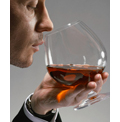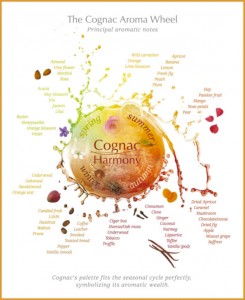 The taste of any drink or food differs from one taster to another so it is difficult to be precise on an interpretation of flavour. However, most people do understand general flavours that they regularly experience. For example, milk, coffee, orange and tea are all daily experiences but defining any one of these flavours is daunting. Perhaps even more so, is the conversion of aroma to taste. For example, we often describe a cognac as oak flavoured. We may have tasted oak-smoked salmon but how do we explain the taste of oak by itself? Much of what we taste can be described by our perception of the aroma but even this can be misleading. Many people are put off drinking gin by the aroma but when tasted, perhaps with tonic, their perception of the taste changes.
The taste of any drink or food differs from one taster to another so it is difficult to be precise on an interpretation of flavour. However, most people do understand general flavours that they regularly experience. For example, milk, coffee, orange and tea are all daily experiences but defining any one of these flavours is daunting. Perhaps even more so, is the conversion of aroma to taste. For example, we often describe a cognac as oak flavoured. We may have tasted oak-smoked salmon but how do we explain the taste of oak by itself? Much of what we taste can be described by our perception of the aroma but even this can be misleading. Many people are put off drinking gin by the aroma but when tasted, perhaps with tonic, their perception of the taste changes.
 Several years ago the BNIC produced a cognac aroma wheel. It has often been used to help describe flavour but it includes such aromas as wild carnations, oak moss and cigar box. Converting that into taste is complicated so we try and use more familiar tastes. In desperation, however, we have resorted to many continental flavours such as rambutan, mangosteen and kumquats. We also use some old English flavours such as medlar, marrow and thyme. Sometimes, when tasting cognac the flavours will change. This is particularly true of cognacs from the top cru, Grande Champagne. Here we often find nutty, rich fruity flavours which tail off to leave citrus flavours of orange or grapefruit peel. These flavours often mature after many years to provide a much desired ‘rancio’ effect. This is probably best explained as a type of maderisation. It has a slightly musty but rich, pineapple syrup and roasted nut flavour that lasts on the palate.
Several years ago the BNIC produced a cognac aroma wheel. It has often been used to help describe flavour but it includes such aromas as wild carnations, oak moss and cigar box. Converting that into taste is complicated so we try and use more familiar tastes. In desperation, however, we have resorted to many continental flavours such as rambutan, mangosteen and kumquats. We also use some old English flavours such as medlar, marrow and thyme. Sometimes, when tasting cognac the flavours will change. This is particularly true of cognacs from the top cru, Grande Champagne. Here we often find nutty, rich fruity flavours which tail off to leave citrus flavours of orange or grapefruit peel. These flavours often mature after many years to provide a much desired ‘rancio’ effect. This is probably best explained as a type of maderisation. It has a slightly musty but rich, pineapple syrup and roasted nut flavour that lasts on the palate.
If flavours are difficult to describe, some of the jargon used in the professional tasting world can be almost unintelligible. We talk about ‘the nose’ when describing an aroma, ‘a finish’ when considering how the flavour ends in the mouth or ‘a tail’ when we consider how a flavour extends to the finish. The term ‘flatness’ is used when the cognac is largely neutral in flavour and when sugar has been added, it is identified as being ‘sticky’. ‘Oily’ is used to describe water in cognac that hasn’t mixed properly with the spirit and ‘dead’ when all you can taste are the additives.
Many years ago I was asked by a famous cognac author to describe the flavour of a cognac that has ‘gone off’. This describes a cognac where most of the alcohol has evaporated and a watery and mouldy residue is left. After a lot of consideration, I told him that it was rather like drinking water in which you have washed some dirty old leather boots! He laughed like a drain and included it in his last book as another way of accounting for taste. I should add that I have only ever tasted this effect a handful of times in 30 or 40 years of tasting. Should you ever be in doubt about a cognac’s suitability for drinking, do not worry. There is never any doubt about one that has gone off!
Next month we will try and explore as many flavours as possible.
 A professor of experimental psychology at the University of Oxford, has said that “venues playing their music too loud are at risk of dulling diners’ taste buds”. He also revealed that “loud music can make it harder to discern a drink’s alcohol content, which may drive diners to buy more booze”. Perhaps certain restaurants are using music to alter diners’ moods – fast food restaurants are known for their high-octane soundtracks which encourage diners to eat quickly and leave. Fergus Henderson of St. John on the other hand has a no music policy at his Farringdon restaurant, and Nigella Lawson believes a thumping soundtrack is “utterly draining and drowns out the taste of the food”. Stephen Harris from The Sportsman probably has it right. He believes the key to a successful restaurant playlist is to pick songs that blend into the background rather than demand to be heard. That does sound like a much more enjoyable dining experience. Interestingly, we have previously reported that wine and spirits are described in a similar way to music, as they have different ‘notes’. Citrus flavours are seen as high notes, while wood and chocolate are low notes. Just wondering whether the choice of background music could influence the customer’s choice of cognac …
A professor of experimental psychology at the University of Oxford, has said that “venues playing their music too loud are at risk of dulling diners’ taste buds”. He also revealed that “loud music can make it harder to discern a drink’s alcohol content, which may drive diners to buy more booze”. Perhaps certain restaurants are using music to alter diners’ moods – fast food restaurants are known for their high-octane soundtracks which encourage diners to eat quickly and leave. Fergus Henderson of St. John on the other hand has a no music policy at his Farringdon restaurant, and Nigella Lawson believes a thumping soundtrack is “utterly draining and drowns out the taste of the food”. Stephen Harris from The Sportsman probably has it right. He believes the key to a successful restaurant playlist is to pick songs that blend into the background rather than demand to be heard. That does sound like a much more enjoyable dining experience. Interestingly, we have previously reported that wine and spirits are described in a similar way to music, as they have different ‘notes’. Citrus flavours are seen as high notes, while wood and chocolate are low notes. Just wondering whether the choice of background music could influence the customer’s choice of cognac …
 Scientists have produced an artificial tasting tongue. It is made from sub-microscopic slices of gold and aluminium which create ‘tastebuds’ that are around 500 times smaller than the human equivalent. Subtle differences in how the metals absorb light allow the ‘tongue’ to identify individual spirits with more than 99% accuracy. Picking up differences in complex chemical mixtures, sometimes resulting from barrel type and length of maturation, it is hoped that the ‘tongue’ will be used to identify counterfeit products. Artificial tongues have been produced before, but this is the first time that two different types of nanoscale metal ‘tastebuds’ have been used so the results are faster and more accurate. So, is this a threat to our industry’s sommeliers? Perhaps not. It may well be more sensitive than the most highly tuned palates, but it cannot describe taste nor identify balance, skills which we specialise in here at
Scientists have produced an artificial tasting tongue. It is made from sub-microscopic slices of gold and aluminium which create ‘tastebuds’ that are around 500 times smaller than the human equivalent. Subtle differences in how the metals absorb light allow the ‘tongue’ to identify individual spirits with more than 99% accuracy. Picking up differences in complex chemical mixtures, sometimes resulting from barrel type and length of maturation, it is hoped that the ‘tongue’ will be used to identify counterfeit products. Artificial tongues have been produced before, but this is the first time that two different types of nanoscale metal ‘tastebuds’ have been used so the results are faster and more accurate. So, is this a threat to our industry’s sommeliers? Perhaps not. It may well be more sensitive than the most highly tuned palates, but it cannot describe taste nor identify balance, skills which we specialise in here at  The taste of any drink or food differs from one taster to another so it is difficult to be precise on an interpretation of flavour. However, most people do understand general flavours that they regularly experience. For example, milk, coffee, orange and tea are all daily experiences but defining any one of these flavours is daunting. Perhaps even more so, is the conversion of aroma to taste. For example, we often describe a
The taste of any drink or food differs from one taster to another so it is difficult to be precise on an interpretation of flavour. However, most people do understand general flavours that they regularly experience. For example, milk, coffee, orange and tea are all daily experiences but defining any one of these flavours is daunting. Perhaps even more so, is the conversion of aroma to taste. For example, we often describe a  Several years ago the
Several years ago the